Table of Contents
This big colourful ball was designed for way more than just occasional sitting or sporadic back stretching. It is a multifunctional aid which can be used for full-body workout and can help you improve your balance. You can exercise with it at home as well as in the gym, and thus diversify your training. If you’re already tired of the bodyweight or dumbbell workout, or you need a new impulse, the fit ball might be the right choice for you, since exercising with it is both effective and fun! In the article, you will find 10 effective fit ball exercises to strengthen your core as well as legs and buttocks.
Why is it beneficial to exercise with the fit ball?
Fit ball is a practical training aid which you can buy and easily store at home. You simply blow it using a pump, and you’re ready to exercise. It will also be appreciated by people who have a sedentary job causing back troubles. When sitting and swinging on a fit ball, you engage the muscles of the deep stabilizing system (core), which can result in better body posture. However, it is not advisable to sit on the ball all day because by doing so you could, on the contrary, overload the activated muscles of the back and abdomen. For a start, 30 minutes will be enough. [1-2]
However, if you want to get the most out of this handy aid, you must do more than just sitting on it. You should also include it in your training routine. It will perfectly test your balance and coordination skills. If these are your weaknesses, don’t worry. By exercising regularly with a fit ball, you can easily improve little by little in these areas. [3-4]
When exercising with a fit ball, you also engage and strengthen the muscles of the core of the body, which are sometimes referred to as core or deep spinal stabilizing system. It is crucial not only for the right body posture during daily activities, but also with any sport. Strong core of the body will come in handy while lifting heavy weights, running and other favourite activities. At the same time, you will support the body’s natural protection against injury. Depending on which exercises you choose to include in your training, you will be able to engage your other body parts. Thus, fit ball allows you to train the muscles of your arms, back and legs. [5–6]
If you are looking for other ways to strengthen the core of the body, try the training in our article How to Train with the Suspension Trainer? Try These Effective Full-Body Exercises.

How to train with the fit ball?
In addition to the fit ball, you will need a mat and plenty of space around you for the exercise. You can choose just some of the exercises below and include them in your training, or you can try all 10.
Try HIIT, for example:
- complete one exercise for 30 seconds, followed by a 30-second rest,
- move on to another exercise and once you go through them all, one set is done,
- if you include all 10 exercises, 1 set will last 10 minutes,
- take a 1-2 minute break between the sets,
- complete 2-3 sets this way.
Or a circuit training:
- complete 8-20 repetitions of each exercise, one by one,
- in case of isometric exercises such as plank, try to stay in this position for at least 20 seconds,
- complete 2-3 sets this way,
- take a 1-2 minute break between the sets.
You might be interested in these products:
10 Stability Exercises for Strong Core, Legs and Booty
These exercises are great for your core, but you will also engage your leg and butt muscles. Try to do them slowly while controlling your movement because it takes a great stability and coordination. Don’t forget to warm up slightly before the training (running on the spot or jumping rope). Then warm up your whole body by doing a circular motion in your large joints. After the main part, take a few minutes to stretch.
1. Plank
- Starting position: Rest your forearms on the ball and extend your legs. Keep your body tight and try to maintain it in line.
- Performance: Breath naturally, keep your body tight and try to maintain this position for a few seconds.
- Common mistakes: Back is bent, pelvis is too high.

2. Rotation
- Starting position: Mid-stance with legs shoulder-width apart. Grab the fit ball with your arms extended, straighten your back and hold the ball in front of your body.
- Performance: Activate your abs and rotate the ball to the side. The movement comes from the whole upper body. Keep your arms extended. Come back to the centre and do the same movement to the other side.
- Common mistakes: Arms are bent, insufficient or excessive rotation, round back.
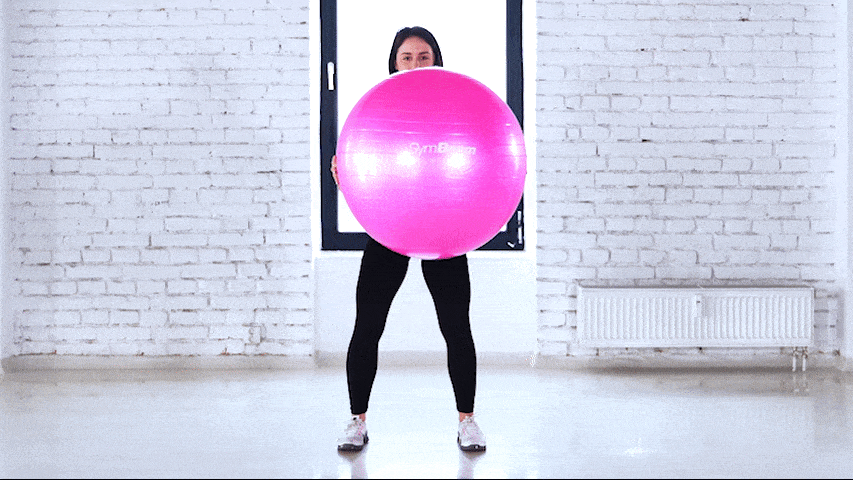
3. Lunges
- Starting position: Stand up and put the ball behind you. Bend your knee and put your instep on the ball. The other leg is upright. Your arms are along your body.
- Performance: Keep your body tight and push the leg on the ball backwards. At the same time, bend your supporting leg and extend your arms forward for a better stability. Try to almost create a line with your body in the lower position. First complete one set on one leg, then on the other.
- Common mistakes: Small range of motion, body rotates to the sides.
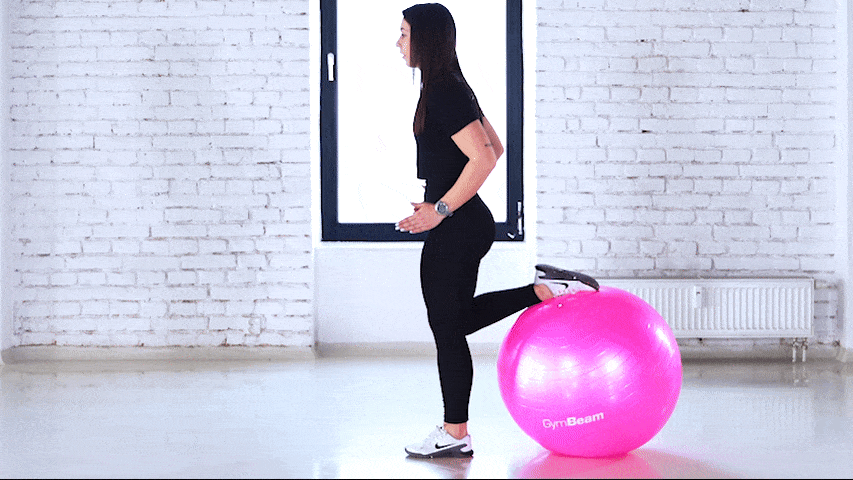
4. Squats
- Starting position: Mid-stance with legs shoulder-width apart. Grab the ball on both sides, raise your head and straighten your back. Activate your core. Arms remain extended.
- Performance: Do a squat with the ball above your head. Try to imitate the process of sitting down in a low chair. Try to maintain your back curved naturally and your bodyweight on your whole foot. There is no need to go too low, a 90° angle at your knees is just enough.
- Common mistakes: Back is bent, leaning forward, too small range of motion, knees are not in line with ankles and toes, insufficient range of motion.
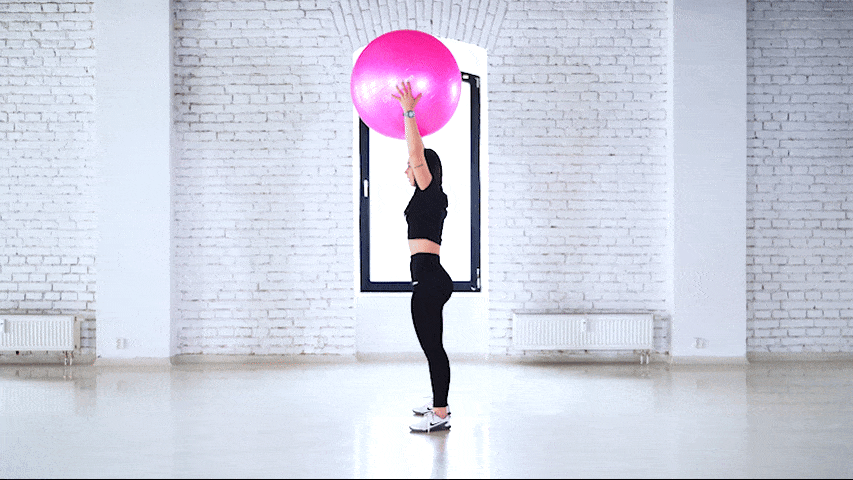
5. Crunches
- Starting position: Lie on the fit ball, bend your knees and leave your feet on the floor. Bend your elbows and place them on your temples.
- Performance: Start doing crunches by activating your abs. Inhale in the lower position, exhale in the upper. On your way up, only raise your head, neck and upper back.
- Common mistakes: Abs aren’t engaged enough.

6. Dead Bug
- Starting position: Lie on your back, grab the fit ball with your hands and raise it above your body. Then also raise your legs and rest your toes on the ball. Arms remain extended.
- Performance: Inhale, brace your core and put your right arm and left leg on the floor while exhaling. Your left arm and right leg still hold the ball during this movement. Then return your limbs to the starting position and repeat the movement on the other side. Always put the opposite arm and leg on the floor. Press the back to the mat all the time.
- Common mistakes: Abs aren’t engaged enough, back is raised, lower back is bent.

7. V-ups
- Starting position: Lie on your back, place the fit ball between your ankles and press it tight. Extend your legs and stretch your arms above your head.
- Performance: Inhale, brace your core and raise your legs extended with the ball above your body. Simultaneously raise your extended arms. Once the ball is above the core of the body, grab it with your hands. Then lower down to starting position with your arms and ball behind your head. Inhale again and press the ball back between your ankles with the same movement. Press the back to the mat all the time.
- Common mistakes: Abs aren’t engaged enough, back is raised, lower back is bent.
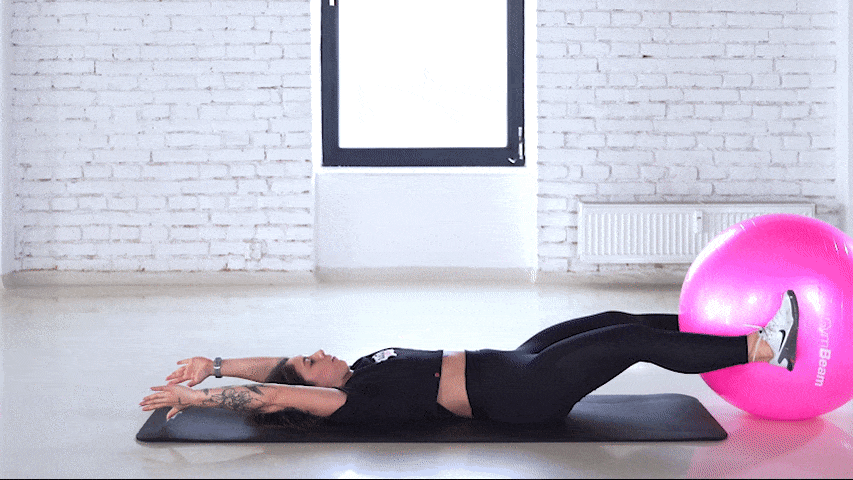
8. Glute Bridge
- Starting position: Lie on your back, bend your legs to about 90° and rest your feet on top of the fit ball. Place your arms along your body with palms facing down.
- Performance: Lift your pelvis upwards by simultaneously activating the core of the body and the glutes while exhaling. Your head, upper back and arms remain on the mat and serve as your support. Lower your pelvis and lift it again once you have lightly touched the mat. Lift the pelvis only as high, so that you feel your glutes are engaged.
- Common mistakes: Back is too bent, glutes and abs aren’t engaged enough, back is raised, insufficient or excessive range of motion in the upper position.
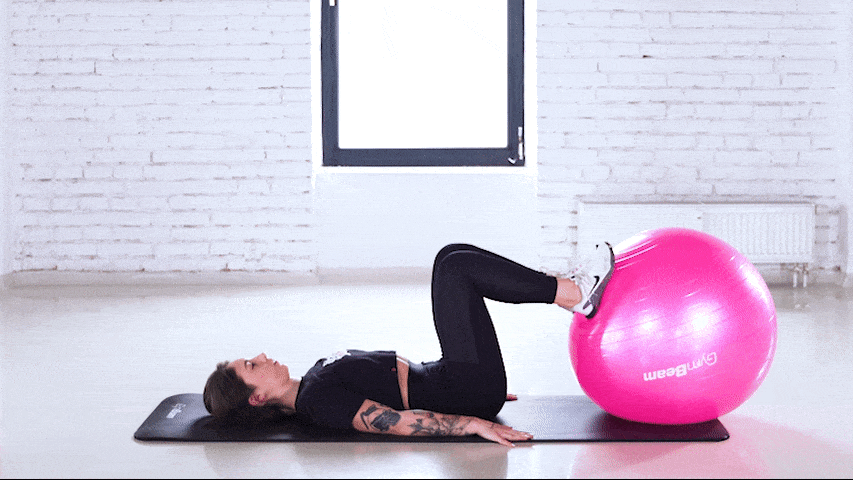
9. Hamstring Curl
- Starting position: Lie on your back, extend your legs and place your heels on top of the fit ball. Place your arms along your body with palms facing down.
- Performance: Lift your pelvis by activating your glutes. Your head, upper back and arms remain on the mat and serve as your support. Roll the ball towards you by bending your knees and rolling your legs from heels to feet. You should feel your hamstrings engaging while rolling. Engage the core as well. Keep the pelvis up during the whole exercise.
- Common mistakes: Back is too bent, glutes, thighs or abs aren’t engaged enough, small range of motion.
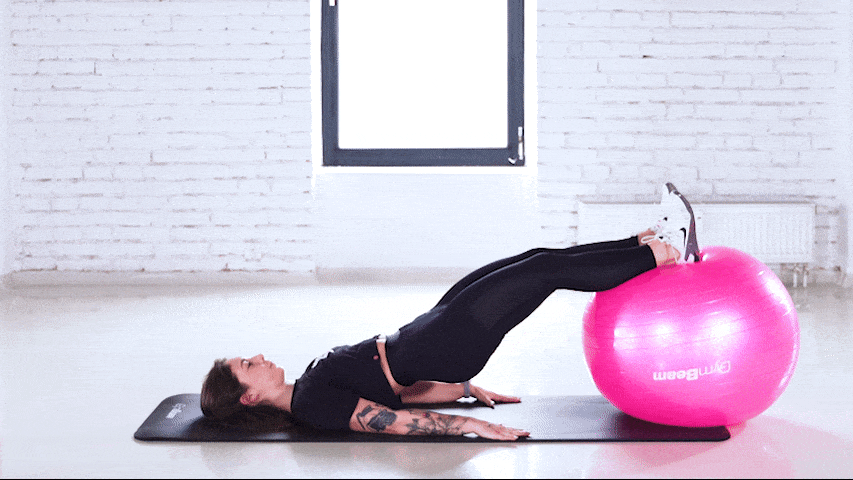
10. Fit Ball Pike
This exercise is more suitable for advanced sportsmen. It requires a strong core of the body and good coordination. If you don’t dare to try it yet, feel free to perform the easier variation listed below.
- Starting position: Kneel on the floor and place the fit ball behind you. Rest your hands on the mat with your arms extended and place your feet on the ball. The shoulders are above the arms. By doing so, you will get to a high-plank position. Keep your body tight and try to maintain it in line.
- Performance: Lift your hips up by activating your abs and try to get them in line with your shoulders. You can increase the range of motion gradually. Legs and arms remain extended. Stay in the upper position for 1-2 seconds and then return to the starting (plank) position and repeat the exercise
- Common mistakes: Back is bent in the starting position.
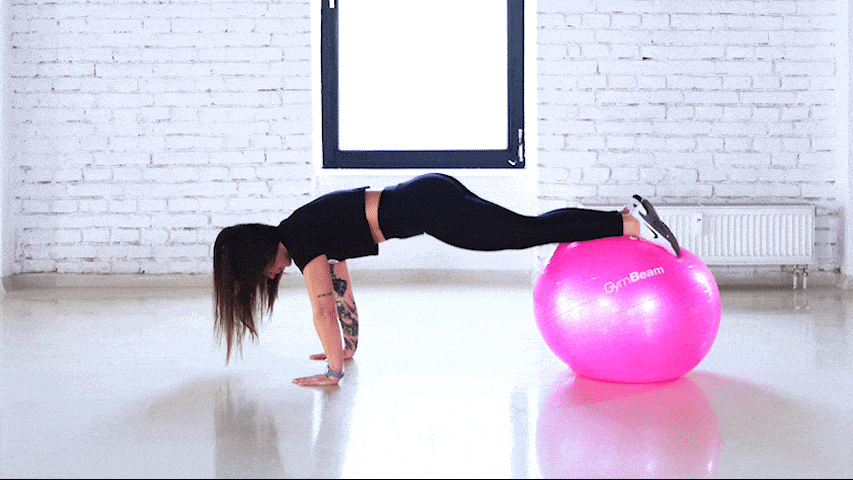
Easier variation: Plank Knee Pull
- Starting position: Place your feet on the ball and rest your extended arms on the floor. The shoulders are above the arms. By doing so, will get to a high-plank position. Keep your body tight and try to maintain it in line.
- Performance: Roll the ball towards you by pulling your knees towards your chest. Then return to the plank position and repeat the movement.
- Common mistakes: Back is bent, small range of motion.
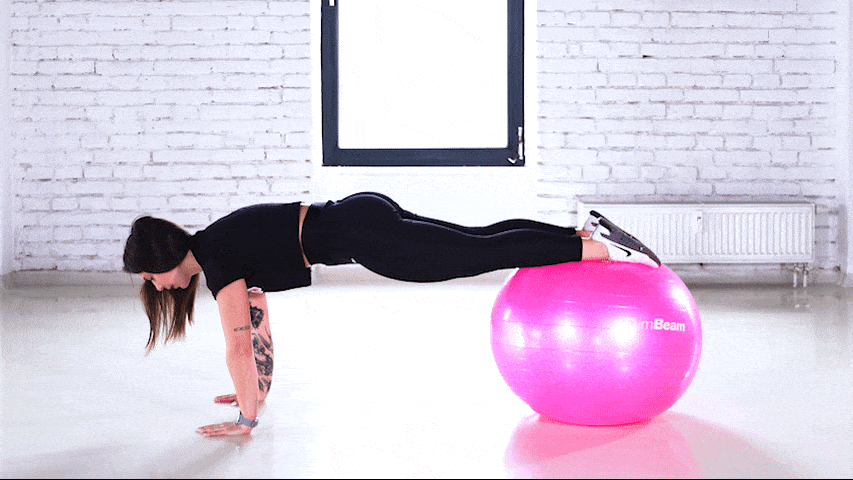
Fit Ball Core & booty Workout
What should you remember?
Fit ball exercises can help you diversify your training. By including them in your workout, you will strengthen the core of the body and also the muscles of the lower limbs. At the same time, you will work on balance and coordination. You can now add HIIT or a circular training with the fit ball to your weekly plan. Thanks to today’s article, you already know that the fit ball is not only great for sitting, but you can also have a great workout with it. Share the article with your friends, who could also appreciate training tips regarding this fitness aid.
[1] 3 Reasons Why Sitting On A Stability Ball Is Good For Your Spine. – https://midmissouriclinicofchiropractic.com/3-reasons-why-sitting-on-a-stability-ball-is-good-for-your-spine/
[2] DC, T. H. Exercise Ball Uses. – https://www.spine-health.com/treatment/physical-therapy/exercise-ball-uses
[3] ACE . Programming Spotlight: Stability and Mobility Training With the Stability Ball. – https://www.acefitness.org/education-and-resources/professional/prosource/september-2015/5578/programming-spotlight-stability-and-mobility-training-with-the-stability-ball/
[4] Larsen, E. 4 Proven Benefits of Stability Ball Exercises: Science And Facts – https://www.hometraininghero.com/benefits-stability-ball-exercises-science-behind-effectiveness/
[5] Yu, W., Cha, S., & Seo, S. The effect of ball exercise on the balance ability of young adults. – https://doi.org/10.1589/jpts.29.2087
[6] Srivastav, P., Nayak, N., Nair, S., Sherpa, L. B., & Dsouza, D. Swiss Ball Versus Mat Exercises For Core Activation of Transverse Abdominis in Recreational Athletes. – https://doi.org/10.7860/JCDR/2016/23102.8972


Add a comment